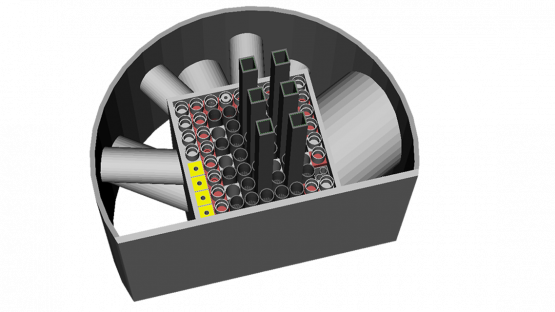Under a recently completed IAEA project, experts have developed a benchmark database for computational methods and tools used for the utilization, operation and safety analysis of research reactors.
A benchmark in this context is an experiment conducted in a research reactor, including the measured data and sufficient details about the research reactor and the experimental facility.
“The benchmark allows modelling the experiment using a computer code,” said Frances Marshall, the lead officer of the four-year IAEA coordinated research project (CRP). “The results of the calculations are compared with the data to assess whether the code and the modelling done are adequate for the case under study.”
Benchmarking computational codes and methods against experimental data is key to assessing the validity of the codes’ application to the design, operation, utilization and safety analysis of research reactors.
The benchmarks can be used to:
- train new professionals in research reactors by allowing them to develop their modelling skills using well-documented cases (benchmarks);
- improve modelling requiring advanced code functions and user knowledge;
- conduct formal validation of codes, models or user qualifications.
The CRP benchmarked many of the most common research reactor codes used at international level, and demonstrated that the codes, methods and the nuclear data available yield results that, in the majority of cases, meet the operational requirements of research reactor facilities.
The collected data will be used to update the IAEA’s Research Reactor Benchmarking Database: Facility Specification and Experimental Data, which is a valuable resource for assisting the optimization of research reactor core management and experimental programmes, while maintaining safety.
The project was carried out by several research reactor operating organizations with ongoing irradiation and measurement activities in fuel burnup and material and target activation. The participants provided experimental data and research reactor facility specifications covering a broad range of research reactor types and power levels. The quality of the data was assessed by an independent review to confirm its use as benchmarks, leading to the establishment of 14 benchmark specifications using data from nine different research reactors. Calculations were then made by at least two participants for each of the benchmarks, using a wealth of codes, leading to a total of 53 analysis contributions.
The overall objective of the CRP was to encourage cooperation, foster the exchange of information and increase the knowledge and expertise in numerical analysis to improve the design, operation, utilization, safety and decommissioning of research reactors, in particular in fuel multicycle depletion analysis, and material and target activation calculations.
The CRP specific research outcomes defined to achieve these targets were to:
- transfer knowledge through increased cooperation in the area of research reactor numerical analysis, including design, safety analysis, operation and utilization;
- enhance capabilities of the CRP participants in performing numerical analysis and safety assessment of research reactors;
- collect sets of experimental data of fuel burnup and material/target activation and compile a comprehensive database useful for performing benchmarks;
- benchmark fuel burnup and material/target activation computer codes against experimental results; and
- develop recommendations for future research and development activities involving research reactors and the codes used to model them.
“The impact of the CRP was immediate,” said Marshall. “Many of the participants used this CRP as an educational opportunity for their junior staff and to develop deeper understanding of their reactor physics modelling tools and approaches.”
More information on this CRP can be found here.






